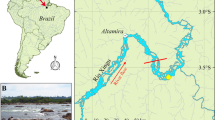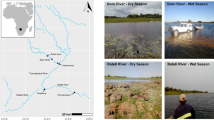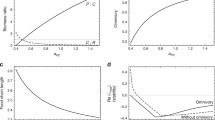Abstract
Food web subsidies from external sources (“allochthony”) can support rich biological diversity and high secondary and tertiary production in aquatic systems, even those with low rates of primary production. However, animals vary in their degree of dependence on these subsidies. We examined dietary sources for aquatic animals restricted to refugial habitats (waterholes) during the dry season in Australia’s wet–dry tropics, and show that allochthony is strongly size dependent. While small-bodied fishes and invertebrates derived a large proportion of their diet from autochthonous sources within the waterhole (phytoplankton, periphyton, or macrophytes), larger animals, including predatory fishes and crocodiles, demonstrated allochthony from seasonally inundated floodplains, coastal zones or the surrounding savanna. Autochthony declined roughly 10% for each order of magnitude increase in body size. The largest animals in the food web, estuarine crocodiles (Crocodylus porosus), derived ~80% of their diet from allochthonous sources. Allochthony enables crocodiles and large predatory fish to achieve high biomass, countering empirically derived expectations for negative density vs. body size relationships. These results highlight the strong degree of connectivity that exists between rivers and their floodplains in systems largely unaffected by river regulation or dams and levees, and how large iconic predators could be disproportionately affected by these human activities.



Similar content being viewed by others
References
Anderson WB, Wait DA, Stapp P (2008) Resources from another place and time: responses to pulses in a spatially subsidized system. Ecology 89:660–670
Arim M, Abades SR, Laufer G, Loureiro M, Marquet PA (2010) Food web structure and body size: trophic position and resource acquisition. Oikos 119:147–153
Bunn SE, Leigh C, Jardine TD (2013) Diet-tissue fractionation of δ15 N by consumers in streams and rivers. Limnol Oceanogr 58:765–773
Davis AM, Blanchette ML, Pusey BJ, Jardine TD, Pearson RG (2012) Gut content and stable isotope analyses provide complementary understanding of ontogenetic dietary shifts and trophic relationships among fishes in a tropical river. Freshw Biol 57:2156–2172
Douglas MM, Bunn SE, Davies PM (2005) River and wetland food webs in Australia’s wet-dry tropics: general principles and implications for management. Mar Freshw Res 56:329–342
Dudgeon D, Arthington AH, Gessner MO, Kawabata Z-I, Knowler DJ, Leveque C, Naiman RJ, Prieur-Richard A-H, Soto D, Stiassny LJ, Sullivan CA (2006) Freshwater biodiversity: importance, threats, status and conservation challenges. Biol Rev 81:163–182
Finlay JC (2001) Stable-carbon-isotope ratios of river biota: implications for energy flow in lotic food webs. Ecology 82:1052–1064
Finlayson CM, Lowry J, Grazia Bellio M, Nou S, Pidgeon R, Walden D, Humphrey C, Fox G (2006) Biodiversity of the wetlands of the Kakadu Region, Northern Australia. Aquat Sci 68:374–399
Forsberg BR, Araujo-Lima CARM, Martinelli LA, Victoria RL, Bonassi JA (1993) Autotrophic carbon sources for fish of the central Amazon. Ecology 74:643–652
Fukuda Y, Webb G, Manolis C, Delaney R, Letnic M, Lindner G, Whitehead P (2011) Recovery of saltwater crocodiles following unregulated hunting in tidal rivers of the Northern Territory, Australia. J Wildl Manag 75:1253–1266
Gooderham J, Tsyrlin E (2002) The Waterbug Book. CSIRO Publishing, Melbourne
Grocke DR, Bocherens H, Mariotti A (1997) Annual rainfall and nitrogen-isotope correlation in macropod collagen: application as a palaeoprecipitation indicator. Earth Planet Sci Lett 153:279–285
Hanson JO, Salisbury SW, Campbell HA, Dwyer RG, Jardine TD, Franklin CE (2015) Feeding across the food web: the interaction between diet, movement and body size in estuarine crocodiles (Crocodylus porosus). Aust Ecol 40:275–286
Hermoso V, Ward DP, Kennard MJ (2012) Using water residency time to enhance spatio-temporal connectivity for conservation planning in seasonally dynamic freshwater ecosystems. J Appl Ecol 49:1028–1035
Hocking MD, Dulvy NK, Reynolds JD, Ring RA, Reimchen TE (2013) Salmon subsidize an escape from a size spectrum. Proc Royal Soc B 280:20122433
Jardine TD, Hunt RJ, Pusey BJ, Bunn SE (2011) A non-lethal sampling method for stable isotope studies of tropical fishes. Mar Freshw Res 62:83–90
Jardine TD, Pusey BJ, Hamilton SK, Pettit NE, Davies PM, Douglas MM, Sinnamon V, Halliday IA, Bunn SE (2012a) Fish mediate high food web connectivity in the lower reaches of a wet-dry tropical floodplain river. Oecologia 168:829–838
Jardine TD, Pettit NE, Warfe DM, Pusey BJ, Ward DP, Douglas MM, Davies PM, Bunn SE (2012b) Consumer-resource coupling in wet-dry tropical rivers. J Anim Ecol 81:310–322
Jardine TD, Hunt RJ, Faggotter SJ, Valdez D, Burford MA, Bunn SE (2013) Carbon from periphyton supports fish biomass in waterholes of a wet-dry tropical river. River Res Appl 29:560–573
Jardine TD, Hadwen WL, Hamilton SK, Hladyz S, Mitrovic SM, Kidd KA, Tsoi WY, Spears M, Westhorpe DP, Fry VM, Sheldon F, Bunn SE (2014) Understanding and overcoming baseline isotopic variability in running waters. River Res Appl 30:155–165
Jardine TD, Bond NR, Burford MA, Kennard MJ, Ward DP, Bayliss P, Davies PM, Douglas MM, Hamilton SK, Melack JM, Naiman RJ, Pettit NE, Pusey BJ, Warfe DM, Bunn SE (2015) Does flood rhythm drive ecosystem responses in tropical riverscapes? Ecology 96:684–692
Layman CA, Quattrochi JP, Peyer CM, Allgeier JE (2007) Niche width collapse in a resilient top predator following ecosystem fragmentation. Ecol Lett 10:937–944
Leroux SJ, Loreau M (2008) Subsidy hypothesis and strength of trophic cascades across ecosystems. Ecol Lett 11:1147–1156
Marcarelli AM, Baxter CV, Mineau MM, Hall RO Jr (2011) Quantity and quality: unifying food web and ecosystem perspectives on the role of resource subsidies in freshwaters. Ecology 92:1215–1225
McCann KS, Rasmussen JB, Umbanhowar J (2005) The dynamics of spatially coupled food webs. Ecol Lett 8:513–523
McCauley DJ, Young HS, Dunbar RB, Estes JA, Semmens BX, Micheli F (2012) Assessing the effects of large mobile predators on ecosystem connectivity. Ecol Appl 22:1711–1717
Moore JW, Semmens BX (2008) Incorporating uncertainty and prior information into stable isotope mixing models. Ecol Lett 11:470–480
Morin A, Lamoureux W, Busnarda J (1999) Empirical models predicting primary productivity from chlorophyll a and water temperature for stream periphyton and lake and ocean phytoplankton. J North Am Benthol Soc 18:299–307
Mosepele K, Moyle PB, Merron GS, Purkey DR, Mosepele B (2009) Fish, floods, and ecosystem engineers: aquatic conservation in the Okavango Delta, Botswana. Bioscience 59:53–64
Murphy BP, Bowman DMJS, Gagan MK (2007) Sources of carbon isotope variation in kangaroo bone collagen and tooth enamel. Geochim Cosmochim Acta 71:3847–3858
Naiman RJ, Bilby RE, Schindler DE, Helfield JM (2002) Pacific salmon, nutrients, and the dynamics of freshwater and riparian ecosystems. Ecosystems 5:399–417
Naiman RJ, Alldredge JR, Beauchamp DA, Bisson PA, Congleton J, Henny CJ, Huntly N, Lamberson R, Levings C, Merrill EN, Pearcy WG, Rieman BE, Ruggerone GT, Scarnecchia D, Smouse PE, Wood CC (2012) Developing a broader scientific foundation for river restoration: columbia River food webs. Proc Nat Acad Sci USA 109:21201–21207
Nakano S, Murakami M (2001) Reciprocal subsidies: dynamic interdependence between terrestrial and aquatic food webs. Proc Nat Acad Sci USA 98:166–170
Nakano S, Fausch KD, Kitano S (1999) Flexible niche partitioning via a foraging mode shift: a proposed mechanism for coexistence in stream-dwelling charrs. J Anim Ecol 68:1079–1092
Natural Resource Management Ministerial Council (2009) Code of practice on the humane treatment of wild and farmed Australian crocodiles. Commonwealth of Australia, Canberra
Novak PA, Douglas MM, Garcia EA, Bayliss P, Pusey BJ (2015) A life-history account of Macrobrachium spinipes (Schenkel, 1902) (Cherabin) in a large tropical Australian river. Freshw Sci 34:620–633
Nowlin WH, Vanni MJ, Yang LH (2008) Comparing resource pulses in aquatic and terrestrial ecosystems. Ecology 89:647–659
Parnell AC, Inger R, Bearhop S, Jackson AL (2010) Source partitioning using stable isotopes: coping with too much variation. PLoS One 5:e9672
Peters RH, Wassenberg K (1983) The effect of body size on animal abundance. Oecologia 60:89–96
Pettit NE, Ward DP, Adame MF, Valdez D, Bunn SE (2016) Influence of aquatic plant architecture on epiphyte biomass on a tropical river floodplain. Aquat Bot 129:35–43
Phillips DL, Newsome SD, Gregg JW (2005) Combining sources in stable isotope mixing models: alternative methods. Oecologia 144:520–527
Polis GA (1999) Why are parts of the world green? Multiple factors control productivity and the distribution of biomass. Oikos 86:3–15
Polis GA, Anderson WB, Holt RD (1997) Toward an integration of landscape and food web ecology: the dynamics of spatially subsidized food webs. Ann Rev Ecol Syst 28:289–316
Pusey BJ, Kennard MJ, Arthington AH (2004) Freshwater fishes of northeastern Australia. CSIRO Publishing, Collingwood, p 684
Quevedo M, Svanback R, Eklov P (2009) Intrapopulation niche partitioning in a generalist predator limits food web connectivity. Ecology 90:2263–2274
Radloff FGT, Hobson KA, Leslie AJ (2012) Characterising ontogenetic niche shifts in Nile crocodile using stable isotope (δ13C, δ15N) analyses of scute keratin. Isot Environ Health Stud 48:439–456
Rayner TS, Pusey BJ, Pearson RG (2009) Spatio-temporal dynamics of fish feeding in the lower Mulgrave River, North-eastern Queensland: the influence of seasonal flooding, instream productivity and invertebrate abundance. Mar Freshw Res 60:97–111
Rezende EL, Albert EM, Fortuna MA, Bascompte J (2009) Compartments in a marine food web associated with phylogeny, body mass, and habitat structure. Ecol Lett 12:779–788
Riede JO, Brose U, Ebenman B, Jacob U, Thompson R, Townsend CR, Jonsson T (2011) Stepping in Elton’s footprints: a general scaling model for masses and trophic levels across ecosystems. Ecol Lett 14:169–178
Robins J, Mayer D, Staunton-Smith J, Halliday I, Sawynok B, Sellin M (2006) Variable growth rates of the tropical estuarine fish barramundi Lates calcarifer (Bloch) under different freshwater flow conditions. J Fish Biol 69:379–391
Rooney N, McCann K, Gellner G, Moore JC (2006) Structural asymmetry and the stability of diverse food webs. Nature 442:265–269
Rooney N, McCann KS, Moore JC (2008) A landscape theory for food web architecture. Ecol Lett 11:867–881
Schoener TW (1989) Food webs from the small to the large. Ecology 70:1559–1589
Smith VH, Tilman GD, Nekola JC (1999) Eutrophication: impacts of excess nutrient inputs on freshwater, marine, and terrestrial ecosystems. Environ Pollut 100:179–196
Thomas SM, Crowther TW (2015) Predicting rates of isotopic turnover across the animal kingdom: a synthesis of existing data. J Anim Ecol 84:861–870
Thornbjarnarson JB, Hernandez G (1992) Recent investigations of the status and distribution of the Orinoco crocodile Crocodylus intermedius in Venezuela. Biol Conserv 62:179–188
Tunney TD, McCann KS, Lester NP, Shuter BJ (2012) Food web expansion and contraction in response to changing environmental conditions. Nat Commun 3:1105
Unmack PJ (2001) Biogeography of Australian freshwater fishes. J Biogeogr 28:1053–1089
Vanderklift MJ, Ponsard S (2003) Sources of variation in consumer-diet δ15N enrichment: a meta-analysis. Oecologia 136:169–182
Ward DP, Hamilton SK, Jardine TD, Pettit NE, Tews EK, Olley JM, Bunn SE (2013) Assessing the seasonal dynamics of inundation, turbidity, and aquatic vegetation in the Australian wet–dry tropics using optical remote sensing. Ecohydrology 6:312–323
Ward DP, Petty A, Setterfield S, Douglas MM, Ferdinands K, Hamilton SK, Phinn S (2014) Floodplain inundation and vegetation dynamics in the Alligator rivers region (Kakadu) of Northern Australia assessed using optical and radar remote sensing. Remote Sens Environ 147:43–55
Winemiller KO, Kelso-Winemiller LC (1994) Comparative ecology of the African pike, Hepsetus odoe, and tigerfish, Hydrocynus forskahli, in the Zambezi River floodplain. J Fish Biol 45:211–225
Woinarski JCZ (2014) The illusion of nature: perception and the reality of natural landscapes, as illustrated by vertebrate fauna in the Northern Territory, Australia. Ecol Manag Restor 15:30–33
Woodward G, Ebenman B, Emmerson M, Montoya JM, Olesen JM, Valido A, Warren PH (2005) Body size in ecological networks. Trends Ecol Evol 20:402–409
Yang L, Bastow JL, Spence KO, Wright AN (2008) What can we learn from resource pulses? Ecology 89:621–634
Acknowledgements
The research team would like to thank Traditional Owners and other Bininj/Mungguy (local Indigenous people) for their support and assistance in undertaking this research. In particular, we would like to thank Steve Winderlich, Anne O’Dea, Jonathon Nadji, Sean Nadji, Fred Hunter, Calvin Murakami, Rob Nobobbob, William Alderson, Samantha Deegan, Kakadu National Park staff, and the Gundjeihmi Aboriginal Corporation as well as Quentin Allsop, Michael Hammer, Peter Kyne, Brad Pusey, Mark Kennard and staff of the RV Solander in the Alligator Rivers Region, and Richard Hunt, Alisha Steward, Stephen Hamilton, Viv Sinnamon and the Kowanyama Aboriginal Land and Natural Resource Management Organization in the Mitchell River. Rene Diocares and Vanessa Fry assisted with sample processing and analysis, and Prabin Rokaya assisted in creating figures. All handling and humane treatment of crocodiles was conducted under Australian government and Kakadu National Park codes. This research was funded by the Australian Government through the National Environmental Research Program’s Northern Australia Hub.
Author contribution statement
TJ, DW, MD, and SB conceived the idea. TJ, TR, NP, and SB refined the field study design. TJ, TR, NP, DV, GL, and SB conducted field work, with DV and GL leading the crocodile component. DV conducted laboratory analyses. TJ wrote the manuscript with editorial input from all authors.
Author information
Authors and Affiliations
Corresponding author
Additional information
Communicated by Leon A. Barmuta.
Electronic supplementary material
Below is the link to the electronic supplementary material.
Rights and permissions
About this article
Cite this article
Jardine, T.D., Rayner, T.S., Pettit, N.E. et al. Body size drives allochthony in food webs of tropical rivers. Oecologia 183, 505–517 (2017). https://doi.org/10.1007/s00442-016-3786-z
Received:
Accepted:
Published:
Issue Date:
DOI: https://doi.org/10.1007/s00442-016-3786-z




